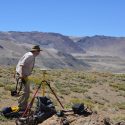Deep-sea drilling expedition off Japan seeks earthquake, tsunami causes
Deep-sea drilling in the Nankai Trough
UW-Madison geologist Harold Tobin describes the Nankai Trough deep-sea drilling project in this video produced by the Integrated Ocean Drilling Program.
This is a video story that requires the Flash 8 or higher player plugin. Download and install it.
Harold Tobin is interested in deep scientific questions, whose answers lie thousands of meters underwater.
The UW–Madison geologist studies deep oceanic earthquake faults, which extend miles into the Earth’s crust below the seafloor, to learn what causes earthquakes and tsunamis. Tobin is currently at sea aboard the Japanese research vessel Chikyu, co-leading an international deep-sea drilling expedition to the Nankai Trough, a region off the southwest coast of Japan that is one of the most active earthquake zones on the planet.
The expedition, part of the Nankai Trough Seismogenic Zone Experiment (NanTroSEIZE), marks the first geologic study of these deep-sea faults, which have previously been inaccessible. Such faults are responsible for generating tsunamis, including the one that devastated Sumatra in December 2004.
The current expedition launched Sept. 21 and will continue through Nov. 16. Progress reports and photos from the ship are available on the Web.
Tags: College of Letters & Science, geology, research, video


